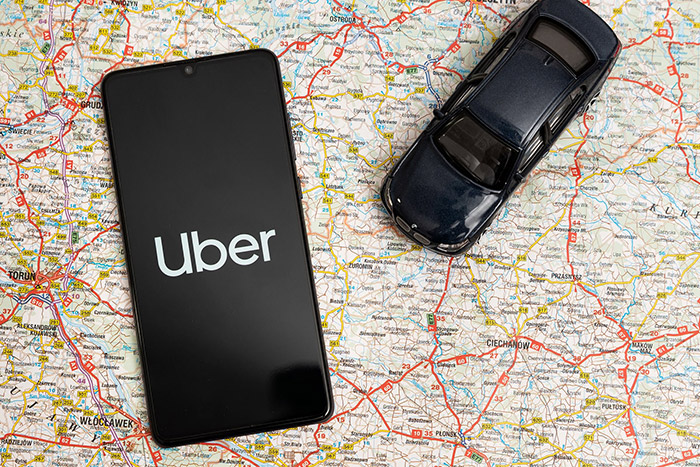Uber and Lyft Ridesharing and Insurance Policy Limits in Nevada
Whether you are a passenger or driver in a rideshare vehicle, it is probably important for you to understand how insurance coverage operates under collisions involving a rideshare vehicle. Rideshare companies are legally referred to as “Transportation Network Companies,” or “TNC’s” and the insurance laws governing TNC’s vary from state to state. Generally speaking, there are some key points to remember:
- As a rideshare driver, you are required to carry your own insurance, however most insurance companies have exclusionary policies applicable to vehicles that are used for rideshare. This means that your own insurance will not provide coverage in situations where you were using your vehicle for rideshare purposes.
- TNC’s, including Uber and Lyft are required to carry commercial insurance policies that cover both drivers and passengers when a vehicle being used for rideshare purposes is involved in a collision.
- TNC coverage is limited in certain circumstances and your coverage eligibility is determined by the “phase” of TNC activity when the collision occurred.
- As a passenger, if you were involved in an accident that involved a rideshare vehicle using a TNC platform, you are entitled to recover under the applicable TNC policy.
Transportation Network Companies – What Are They?
As defined by Nevada Revised Code 706(A), a Transportation Network Company or “TNC” is an “entity that uses a digital network or software application service to connect a passenger to a driver who can provide transportation services to the passenger.” Uber or Lyft are examples of popular TNC’s. The fact that a TNC functions as a platform for ridesharing raises interesting insurance questions and in some circumstances, it can seem confusing.
Who is responsible? Does the TNC pay, or does my own insurance pay? The good news is that the Nevada Department of Insurance (DOI) has compiled a comprehensive PDF answering some of the more frequent questions involving TNC’s. Follow this link for more information: https://doi.nv.gov/uploadedFiles/doinvgov/_public-documents/News-Notes/TNC%20and%20Insurance%20FAQ.pdf
When Does a TNC’s Commercial Coverage Apply?
The answer to this question is… IT DEPENDS. TNC commercial policies are available under some circumstances involving rideshare vehicles, but not all of them. Your coverage status is entirely dependent on which “Phase” of TNC activity the accident occurred in [1]. According to the Nevada DOI, the three phases of TNC activity are defined as follows:
- Phase 1: TNC driver is logged into the app and is available to accept passenger(s).
- Phase 2: TNC driver has accepted a request from a passenger (a “match”) and is in route to pick up the passenger.
- Phase 3: Starts when the passenger enters the vehicle and ends when the passenger fully exits the vehicle.
For Drivers: If you are NOT logged into the app, you are NOT considered to be driving for a TNC.
Both Uber and Lyft use this phase system to determine the extent of applicable coverage that would be extended to you in the event of a collision involving a driver using their rideshare platform. An easy way to break the coverage down is to look at how involved in the rideshare process the driver actually was. The more involved the driver, the more coverage available.

What Is the Minimum Coverage Required in Nevada for TNC Drivers?
Pursuant to Nevada Revised Statute 690B.470, TNC’s are required to continuously provide insurance coverage, “during any period in which the driver is providing transportation services” NRS 690B.470 (1) (a) states that the minimum amount of coverage is as follows:
“In an amount not less than $1,500,000 for bodily injury to or death of one or more persons and injury to or destruction of property of others in any one accident or motor vehicle crash that occurs while the driver is providing transportation services.”
Thus, in Phase 2 or Phase 3 of TNC activity, Nevada law requires that TNC’s provide coverage of up to $1.5 million in any one accident this will include injury, death AND property damage caused by the rideshare driver when engaged and carrying passengers. The limits for Phase 1 of TNC activity, however are decreased to $50,000 per person and $100,000 per collision when logged in, but not transporting. NRS 690B.470 (1)(b) describes phase 1 as a driver being logged into the app, available to receive requests, but not otherwise providing transportation services.
Both Uber and Lyft have information regarding their insurance policies available on their websites. The following is a summary of the coverage limits obtained from Uber and Lyft’s respective websites:
UBER
- Phase 1: During this phase, where the driver is logged into the app, but has not accepted a ride, Uber provides liability coverage to a third party if the driver is involved in an accident that is the drivers fault. The limits are $50,000 per person/$100,000 per accident and $25,000 for property damage.
- Phase 2 – 3: They provide the same liability coverage for both phase 2 & 3—that is a minimum of $1,000,000 per accident. Uber notes that these limits are subject to variation state by state.
- Uninsured or Underinsured motorist coverage (UM/UIM): Uber previously extended UIM benefits of $1,000,000, but now unfortunately offers virtually NO UM/UIM benefits as Nevada law does not require such.
- Personal Use: No Coverage — your own insurance policy applies.
LYFT
- Phase 1: When driver mode is on, but no ride has been accepted, Lyft provides contingent liability coverage to protect you if your personal insurance doesn’t. That is $50,000 per person, $100,000 per accident and $25,000 for Property Damage.
- Phase 2-3: Lyft provides liability coverage from when the ride is accepted through when the ride has ended in the app. The policy has a $1,000,000 per occurrence limit. Lyft notes that coverages may be modified to comply with local regulations and/or state laws.
- UM/UIM: Lyft does not indicate what the policy limits of their UM/UIM policies are but says that it varies by state.
- Driver mode is off: No coverage–your own insurance policy applies.
https://help.lyft.com/hc/en-us/articles/115013080548-Insurance-Policy
What is Uninsured or Underinsured Motorist Coverage?
Uninsured or Underinsured motorist coverage, known as UM/UIM, is designed to protect individuals who are injured in a collision involving a driver that is either underinsured or not insured at all. For example, let’s say that you are injured in an accident while being transported by a TNC driver, and that the at-fault driver only carries a policy with the Nevada state minimum coverage of $25,000. What happens if your medical expenses exceed those policy limits? In this situation, the TNC’s UM/UIM policy will apply because the at-fault driver is “underinsured.” Similarly, if the at fault driver hit and ran, or didn’t have any insurance at all, the TNC’s UM/UIM policy would apply because the driver was “uninsured.”
- See Also: Uber, Lyft, and Ride Accidents in Las Vegas
- See Also: UBER Driver Liability Limits: Customers vs. Non-Contracted Passengers?
- See Also: Ride Sharing: Arbitration Clauses & Independent Contractor vs Employee
[1] “Transportation Network Companies and Auto Insurance: Frequently asked questions.” The Nevada Department of Insurance, http://doi.nv.gov/uploadedFiles/doinvgov/_public-documents/News-Notes/TNC%20and%20Insurance%20FAQ.pdf
[2] Id.
[3] NRS 690B.470 (1)(b)
Free Consultation

